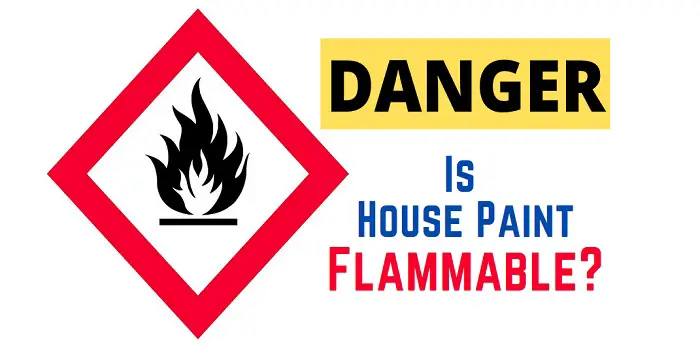
Various different types of spray paints are today used for crafts, experiments, as well as for DIY home projects.
Some of them are safe to use, and some are not.
But the question is – are these spray paints flammable after it dries?
To answer in short…
No, the paints are usually not flammable when dried.
When present in its original container, there are solvents present that make spray paints flammable.
But, once they are applied to the surface, dried, and cured, their solvent evaporates. This makes them combustible but not flammable.
To be precise, it will depend on the type of paint you are using – whether it’s water-based acrylic paint, solvent-based spray paints, or spray paints.
While acrylic paints in liquid form are not flammable, some of the dried acrylics become plastic polymer solid, which can be considered combustible (but not flammable).
The same stands true with other spray paints and oil-based paints.
Note: Combustible means that the product can burn. While the flammable means that the product will burn and can also catch fire much faster and much more violently.
If you want to know more about how flammable your spray paints and their fumes can be, I will try to answer these questions in detail below.
So, let’s dive in…
What's Here in the Article:
Is Paint Flammable?
No matter whether it’s your house paint, fabric paint, or an artist’s paint for canvas painting, they can be flammable to some extent.
The flammability will largely depend on the ingredients (solvents, pigments, binders, etc.) used to manufacture them.
Mostly it’s a solvent present in the paint that will determine how flammable the specific variety of paint is.
Aerosol paints, for example, contain highly flammable butane and propane gases which makes them extremely dangerous.
If not used properly (or used near the fire), these spray paints may even cause an explosion and big damage.
Oil-based paints, enamels, and other solvents like glossy varnishes, clear finishes, epoxy, lacquers, paint removers, wood oils, and stains are also highly flammable.
This is due to the solvents present in them like methyl alcohol, acetone, isopropyl alcohol, methanol, ketones, toluene, etc.
Since these toxic solvents can also be hazardous, you will need to handle them safely when painting or disposing of them.
Water-based house paints, emulsions, chalk paints, and a few glass paints are generally not flammable.
Especially when they are in their liquid form, they won’t catch fire due to the water content present in them.
With that said, it will not be true to say that all the latex, acrylic, or vinyl paint varieties (that are water-based) are not flammable at all.
Some of them present in the market can still be dangerous, and you will need to be careful while dealing with them.
To be safe, you can check for the flammable binders or solvents present in the paint by looking at the paint can when purchasing.
Most popular brands and paint companies clearly state if their product is categorized as flammable or non-flammable paint.
This will help you get the idea of whether the paint you are buying is flammable or can fuel a fire.

How Long is Spray Paint Fumes Flammable?
Although spray painting your walls and ceilings is faster and can provide a more uniform application than conventional paint and brush, the aerosol products used can be dangerous.
Especially the toxic chemical fumes that may linger around (even after the paint) are flammable and should be used cautiously.
The fact is, as long as there are spray paint fumes present in the air, the air around remains to be flammable.
In most cases, it can take between 2 to 4 days to completely get your freshly painted room fume-free.
And until that time, the fumes present can be flammable, and you should avoid smoking (or using any combustible substance) in such a room.
It’s for this reason; you should consider spray paints only for painting the surfaces outside your home.
If spray painting interiors, make sure the area is well-ventilated and safe to work in.
When properly ventilated, the flammable thinner and paint fumes will automatically get removed within a few hours.
The time it takes will, however, depend on the size of your room and the type (or brand) of paint you have used.
Few precautionary tips you can follow to keep safe while spray painting include:
- Do not ever try to puncture the spray can
- Stay away from heat or fire when using house paints
- Read the instructions, labels, and warnings properly before using the paints
- Store all types of flammable paints in a dry place which is away from heat, and direct sunlight
Why Should You Store the Paints in a Flammable Cabinet?
Remember, higher, or lower temperatures can degrade the quality and consistency of paint you are planning to store.
If you keep them at places with too high temperatures, the cans can also burst.
It’s best to store the house paints at locations that are somewhere between 55-80 °F.
In addition, it’s also important to know what kind of paint you are storing and what are the specific OSHA and NFPA requirements.
Since water-based paints are less hazardous, they have fewer restrictions related to storage.
However, if you are storing solvent-based paints they have stricter storage requirements due to the flammable materials they contain.
When to Use Flammable Cabinets?
Flammable paints, if need to be stored safely at the professional level, will require specifically designed cabinets and containers.
The cabinets for storing flammable chemicals and paints are usually required if you are storing a larger volume of liquids – which is more than 25 gallons.
When storing less than this, no storage cabinet is mandatory.
Besides small-sized cabinets that are available to store the paints at home and industries safely, there are also large storage buildings and container boxes available.
If you are storing a very large number of flammable paints, chemicals, or waste, you can get these custom-designed flammable paint storage buildings built as per your requirements.
The good thing about it is you can keep various smaller cabinets in these storage buildings, while you are still waiting for their safe disposal or future use.
Final Thoughts
Paints are the part of our lives that helps make our life colorful.
However, when working with flammable paints in your home, it’s beneficial to know about its materials and the precautions you can take to keep yourself safe.
While oil-based paints and aerosols can be extremely flammable, water-based paints carry very few flammable materials making them safe for use in all conditions.

Douglas Becker (aka Painter Doug) has over twenty years of experience as a painter in Adkins, Texas. At present, he resides in Florida with his family.
From painting multi-storeyed houses, condos, and apartments to large commercial buildings and small offices, he had served various customers in areas not only in Adkins but also in Southwest Florida, Sarasota, Naples, and many more. To know more about him check here.




